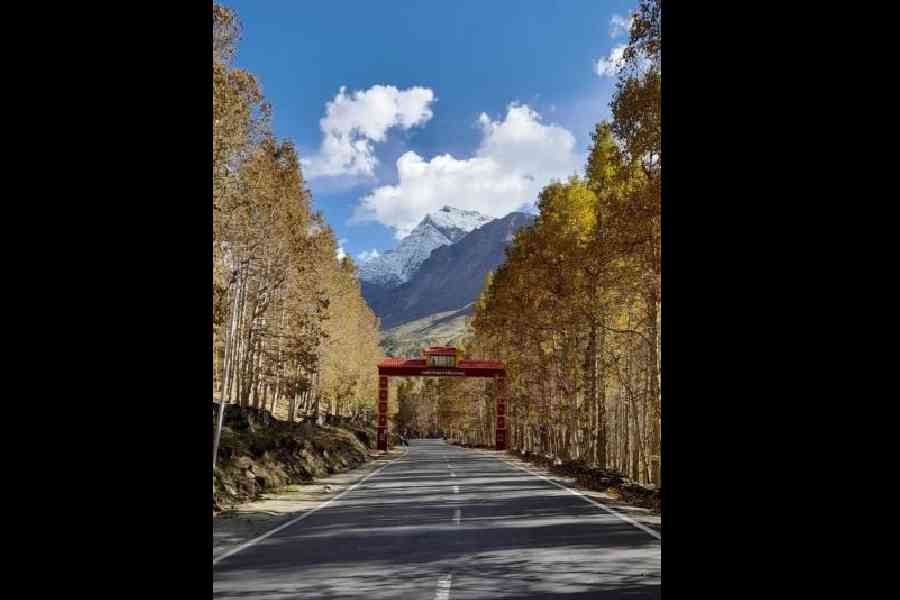Nestled in the tranquil environs of the snowbound tribal belt of Lahaul Valley, Tholang village is situated at a dizzying altitude of about 9,970ft above sea level. While many travellers are drawn to the more famous spots in Himachal Pradesh, like Manali, which is just 113km away, this hidden gem offers a unique escape where visitors are welcomed not just by breathtaking landscapes, but also by the village’s rich culture and the warmth of its people. If you’re looking for an authentic Himalayan experience, Tholang promises peace, beauty, and a sense of connection with nature and tradition.
A Unique Himalayan Treasure
What sets Tholang apart from other hill stations is its rustic charm rooted in simplicity. Home to just around 36 families, Tholang is a tightly-knit community where everyone knows everyone. The village exudes a sense of belonging that visitors will feel the moment they enter the village. As you walk through the narrow lanes, you will notice terraced fields of barley, peas, apples, cherry, cauliflower, zucchini and potatoes — the staple crops of the village. Tholang’s fertile soil and the cool mountain climate make it perfect for producing some of the finest agricultural products in the region, including seed potatoes that are highly valued across the country.

The gateway to heaven welcomes visitors to the Lahaul valley
In recent years, Tholang’s agricultural prowess has expanded beyond subsistence farming. Villagers have begun experimenting with organic farming, producing herbs and medicinal plants. Locals take great pride in their agricultural heritage, which forms the backbone of their simple, self-sustained lifestyle. The harvest season is a time of celebration, where the whole village comes together to reap the rewards of their hard work, reinforcing the deep connection they have with their land.
Ideal for High Mountain Treks
For adventure enthusiasts, the area around Tholang Village offers several thrilling treks that showcase the unspoilt beauty of the region. One popular route is the trek of about 20km to Ghepan Lake, a mesmerising glacial lake surrounded by towering peaks, which promises an unforgettable experience of pristine wilderness. The trek usually involves a combination of rugged terrain and high-altitude paths, offering stunning views of Lahaul valley along the way.
Another option is the trek to Shinkula Pass, a challenging yet rewarding trek that goes through rugged landscapes and high-altitude meadows. These treks not only offer spectacular views of the majestic Himalayas but also allow you to explore the untouched beauty and tranquility of this lesser-known region.
While embarking on these exciting treks it is advisable to be well-prepared. One should ensure physical fitness with cardio and strength training. Acclimatisation to high altitudes by ascending gradually and staying hydrated is another must. Pack essentials like layered clothing, sturdy hiking boots, navigation tools, and first aid. Check weather conditions beforehand, and always carry energy-rich snacks and sufficient water.
A Village of Achievers
Tholang Village may be small, but its achievements are anything but. Over the years, this close-knit community has proudly produced more than 50 distinguished professionals, including IAS, IPS, and HAS officers, along with doctors, engineers, and even individuals in the fashion industry. Locals credit this success to the village’s unwavering focus on education. The village school, though humble, is seen as a beacon of knowledge, with a shared belief that learning can open doors and shape the future. It’s this dedication to education that continues to inspire the village youth to aim high and achieve remarkable success.
It’s no surprise that this Buddhist village boasts a 100 per cent literacy rate, with 90 per cent of its women holding degrees. Embracing education early on, the village has effectively benefitted from government policies on tribal welfare. In a nutshell, education has always been the villagers’ way to make a mark on the world.
A Taste of Tradition: Food, Culture, and Festivals
In Tholang, culture isn’t just preserved, it’s lived every day. The villagers take immense pride in their traditions, from the food they prepare to the festivals they joyously celebrate. One of the highlights is the vibrant Chaga festival, which is celebrated in the month of November. It marks the end of the harvest season and the onset of winter. During this festival, the village comes alive with colorful attire, rhythmic folk songs, and traditional dances like the captivating Shondol.
The local cuisine is a reflection of both the region’s cold climate and its close-knit community. Thukpa, a comforting noodle soup, and momos, steamed dumplings filled with meat or vegetables, are staples in every household. Siddu, a delicious steamed bread stuffed with walnuts and poppy seeds, is another local favourite. No meal in Tholang is complete without a steaming cup of butter tea — a savory drink that perfectly combats the chilly mountain air.
Voices from Tholang
Vikram Kr Kapoor, a village local and orchardist, shares a beautiful anecdote about his family’s connection with the land. “We have been here for generations,” he says, standing beside his lush potato field. “My ancestors worked in this same soil, and when I see my children running through the fields, I know they too will carry this legacy forward.”
His words capture the essence of Tholang — a place where time seems to slow down, allowing people to live in harmony with nature and their traditions. Visitors are often struck by the villagers’ deep connection to the land and their gratitude for its bounty.
Mud Houses: Experience Authentic Lahauli Hospitality
One of the best ways to experience life in Tholang is to stay in one of the village’s homestays and mudhouses, which offer a genuine taste of local hospitality. Guests can indulge in the beauty of the Chenab River, known as Chandrabhaga, right at their doorstep. (See box Tholang’s popular homestays)
Best Time to Visit
The ideal time to visit Tholang is from May to October, when the snow melts and the fields are either in bloom or ripened with crops ready for harvest. While winter transforms the village into a stunning snow-covered wonderland, heavy snowfall can make travel challenging during those months.
So pack your bags and get ready to explore Tholang — a place where the air feels pure, the warmth of the people welcomes you, and every step reveals a story eager to be shared.










